Human Wildlife Conflict Management
- Home
- Human Wildlife Conflict Management
HUMAN-WILDLIFE CONFLICT MITIGATION
The past few centuries have been witnessing the human encroachment into all types of wildlife habitats such as forests, grasslands, wetlands, rivers, mountains, oceans etc. This has resulted in transformation of wildlife habitats into croplands in order to meet the food production demand of ever growing human population. The issue further aggravates with uncontrolled use of artificial fertilizers, pesticides and weedicides. These chemicals are not only lethal to wildlife but they are also the major polluting contributors to groundwater as well as surface freshwater resources like streams, rivers and lakes. Housing development projects, industrialization and construction of roads, offices, dams also cause the loss of habitat and wildlife migration routes. As a result, no option remains for wild animals other than straying in human settlements in search of basic life resources like food and water, resulting in wildlife – human conflict that harms either humans or animals. In addition, traditional practices like illegal poaching, snake charming, bear dancing further intensify such conflict issues. Even animal road accidents have become common occurrences.
Team NACONS is always earnest and equipped to handle any such wildlife emergency. Our rescuers rush to the scene, save the animals in distress, provide the required medical treatment and rehabilitate them to their natural habitat. These rescue operations are always carried in collaboration with the local forest department.
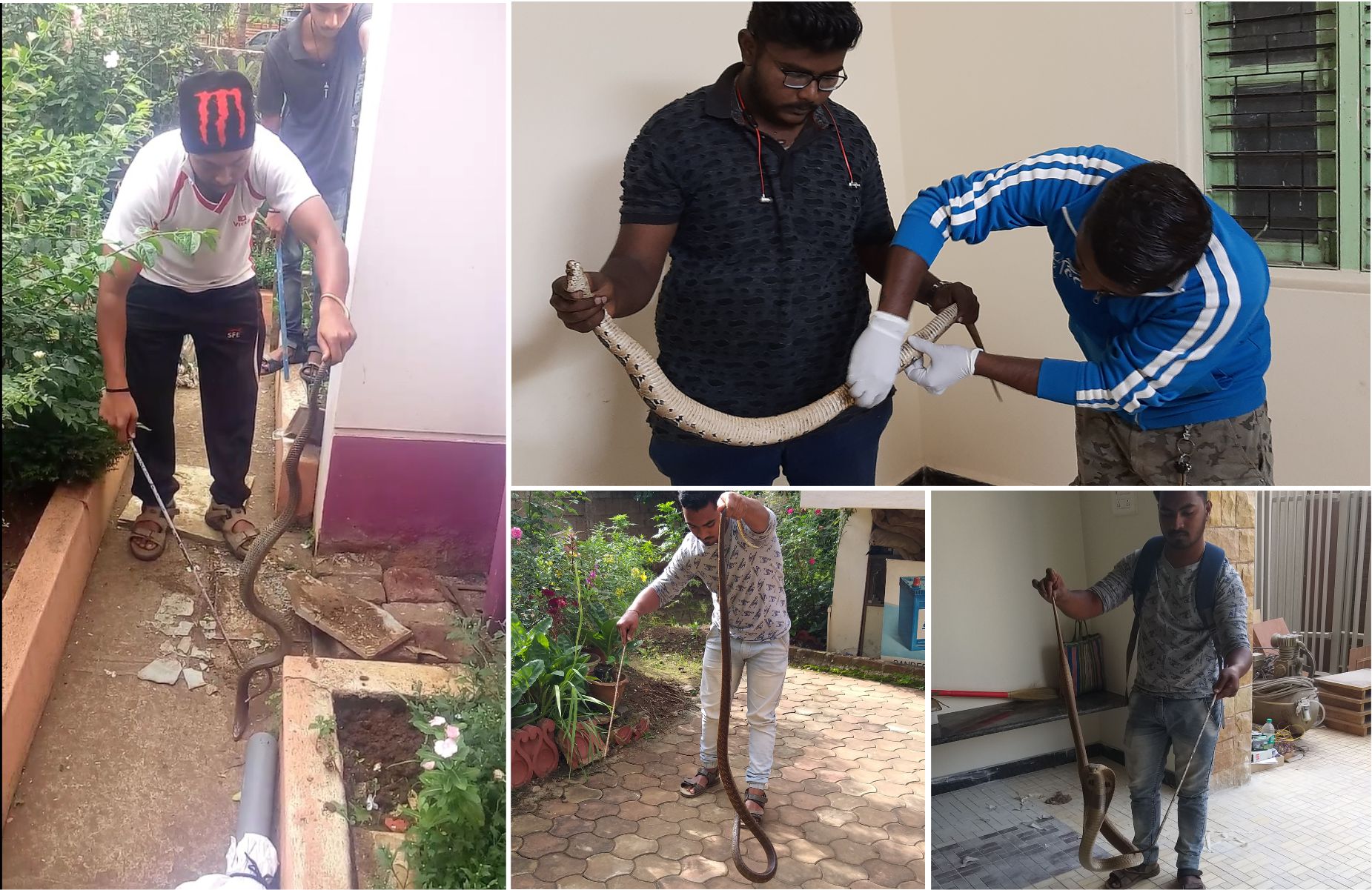
SNAKES
The most common wild animal a man frequently encounters, is the snake. Snakes do not come in human settlements to harm people because humans are not their prey. Humans are surrounded by scavengers like rats and seasonal visitors like frogs, which attract snakes since it is their main food source. Snakes bite humans accidently or when they feel threatened. Hence, snake rescue and rehabilitation is a daily task. Snakes are often drifted to human settlements during heavy floods and get trapped inside the houses when the flood water recedes. They need to be rescued. More than 15 species of snakes including the big four, the commonest venomous snakes of India namely Indian spectacled cobra (Naja naja), Common krait (Bungarus caeruleus), Russell’s viper (Daboia russelli) and Saw scaled viper (Echis carinatus) are found in our area.
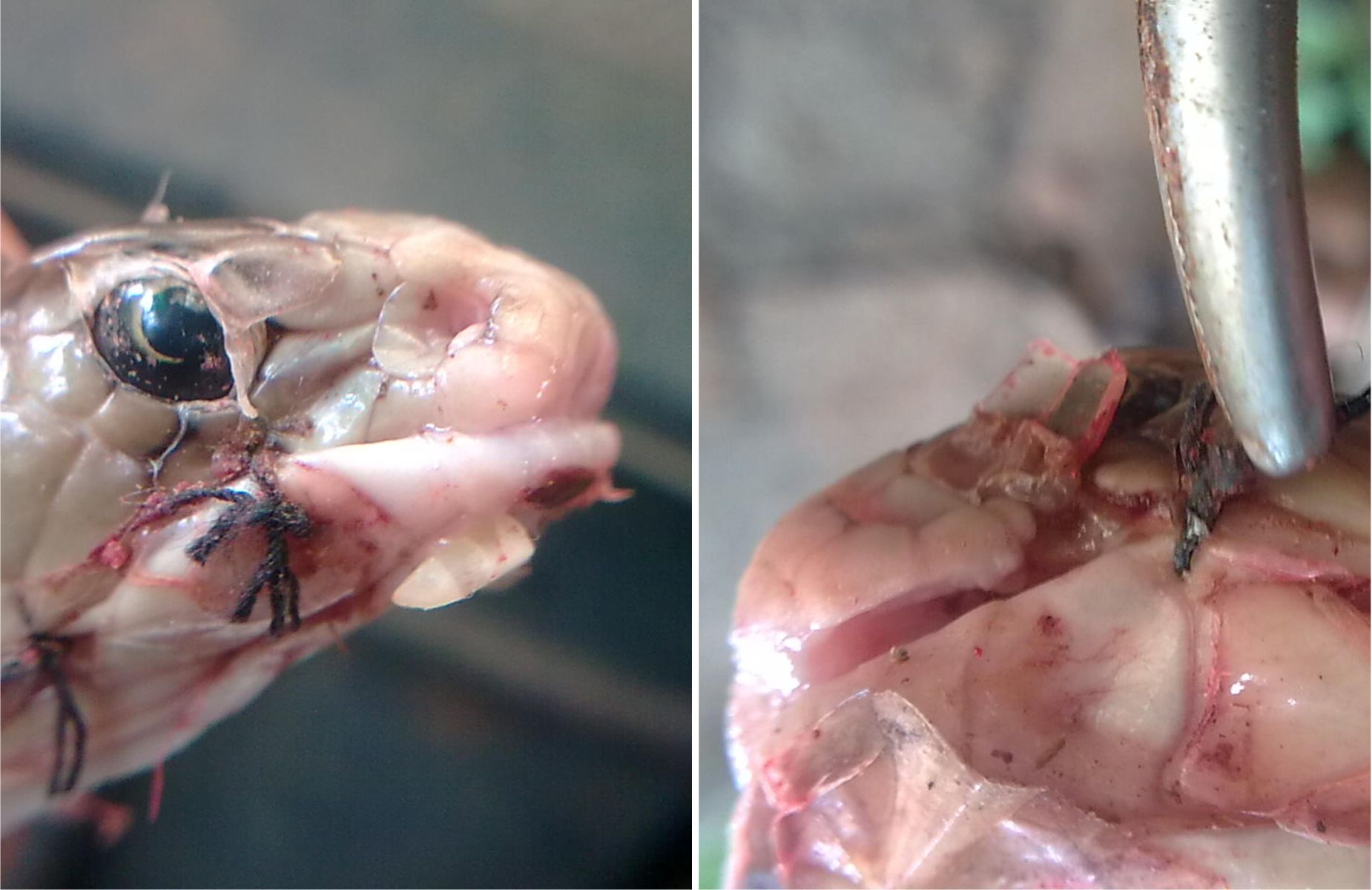
RESCUE FROM SNAKE CHARMERS
Snake charming is a traditional folk-art practiced by professional tribesmen in which snakes are manipulated for street performances. ‘Nag panchami’ is an Indian festival in which cobra snakes are worshipped by people and snake charmers perform their play. Snake charmers often abuse the snakes by force feeding them, removing their fangs or even suturing their mouths to prevent them from biting. NACONS activists have worked relentlessly with the forest department in order to end this abuse and fortunately, this practice has almost become extinct now in our district.

SURGERIES ON WILDLIFE
Snakes have a bad reputation in human society due their fearsome appearance and fatalities caused by venomous snake bites. Sometimes, some over-adventurous people try to kill the snake before rescuers reach the location. The injuries sustained by snake in such incidences are so grave that it needs a surgery. Severe injuries to the snakes such as skin lacerations, intestinal rupture caused by a soil excavator machine or a plough are common. Other wild animals roaming in human settlement also sustain severe injuries caused by electrical burns, kite string entanglement, road traffic accidents and attacks by stray dogs. Such animals do not survive without surgery. ‘Team NACONS’ assists such surgeries which are performed by Veterinary surgeons in the team.
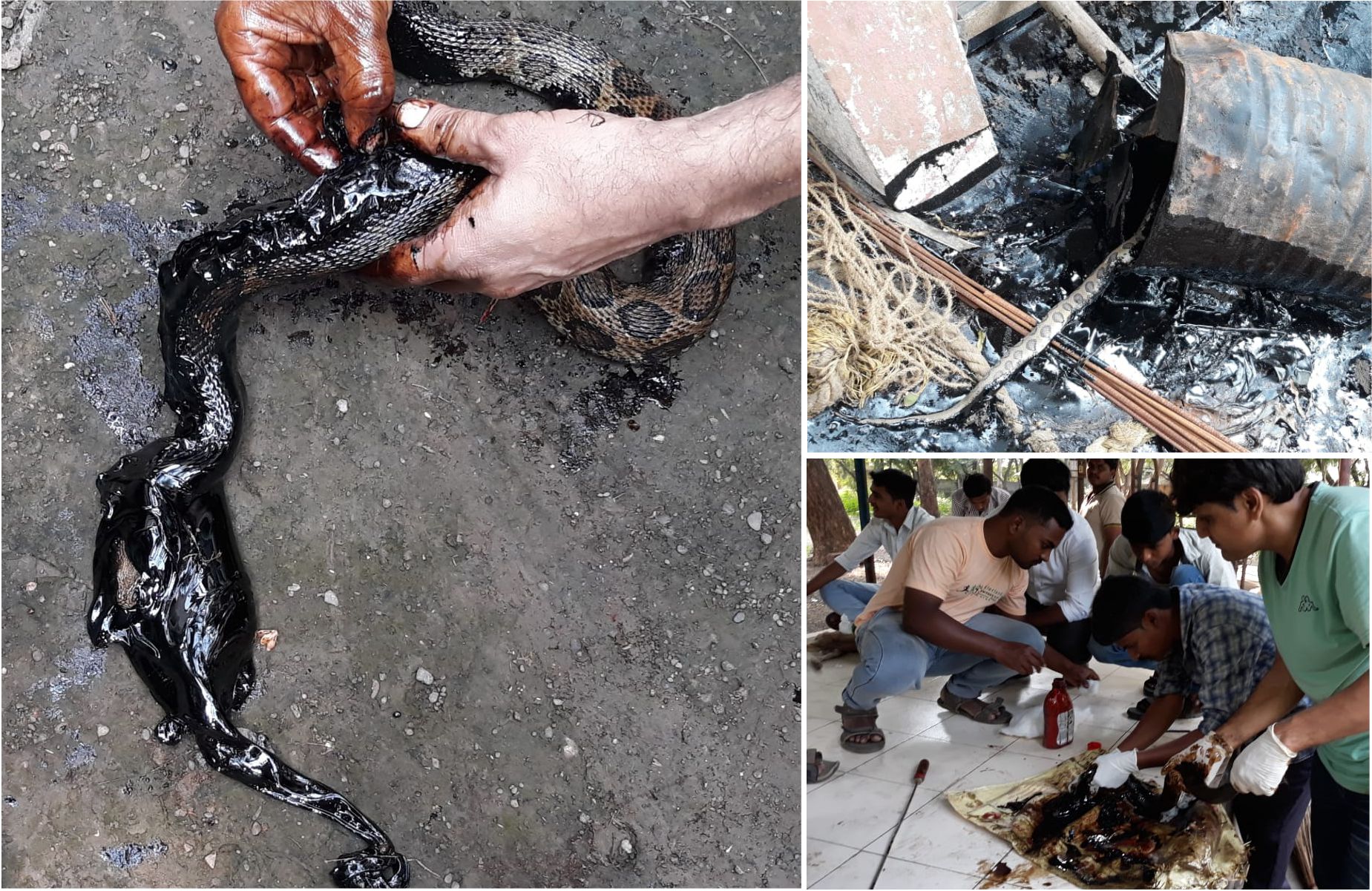
ENTRAPMENT IN TAR
Wild animals often get trapped in the tar discarded by road construction workers. Such rescue operations are very difficult as well as dangerous for the rescuers, especially when trapped animal is a deadly venomous snake such as Russell’s viper (Daboia russelli)
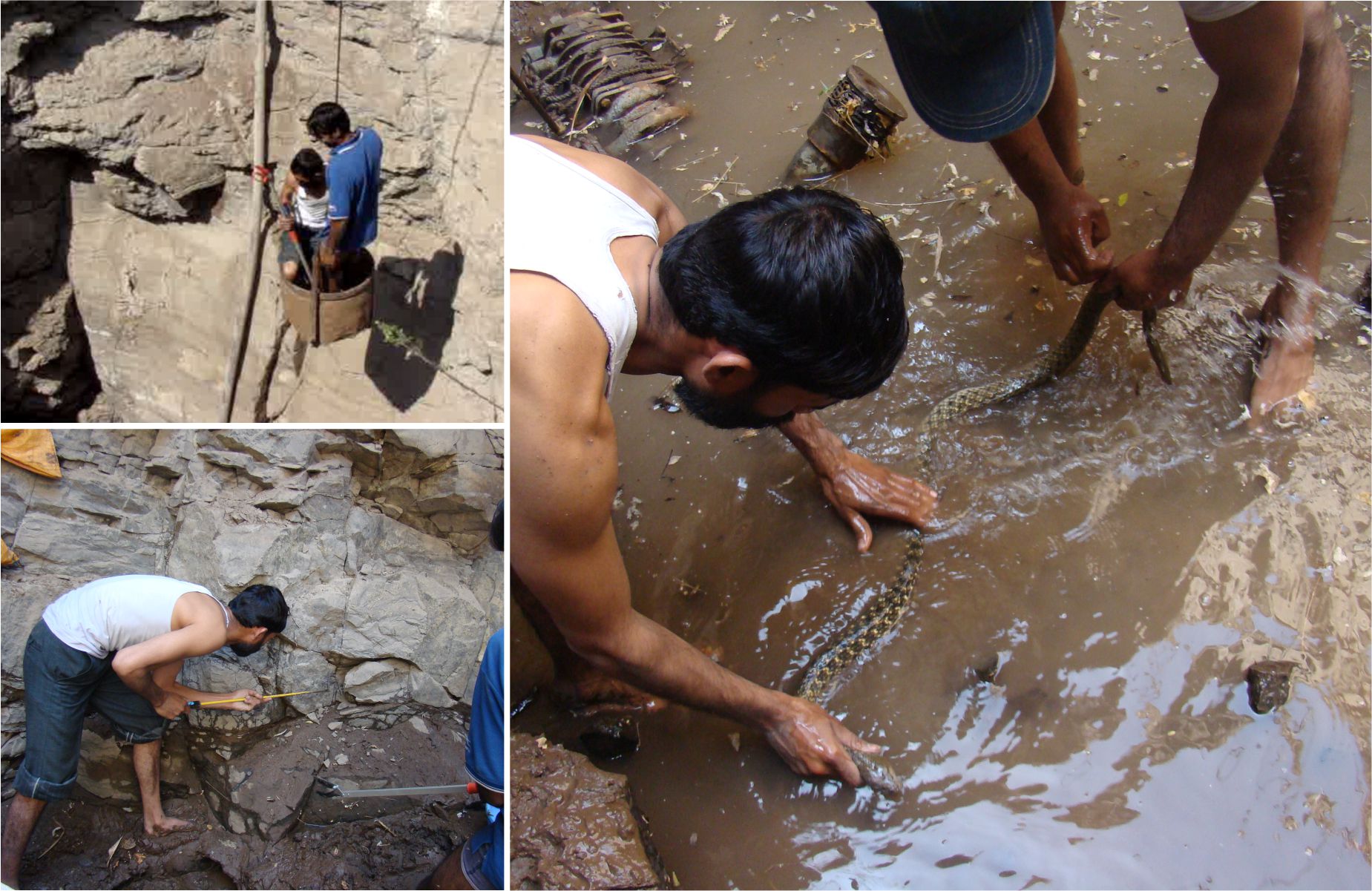
DIFFICULT RESCUE OPERATIONS
Summer is always a difficult season for wildlife. Wild animals are forced to venture out into human settlements due to scarcity of green vegetation, prey base and water sources which puts them at risk of falling into uncovered wells. Leopards, Hyenas, Wolves, Jackals, Civets are the usual victims. Sometimes, snakes also enter open wells in search of food such as frogs, pigeons, fish etc. and get trapped inside. Such rescue operations are difficult and dangerous for both, the trapped animals and rescuers. Our experienced and skilled rescuers perform such difficult operations, even with the limited resources at our disposal.
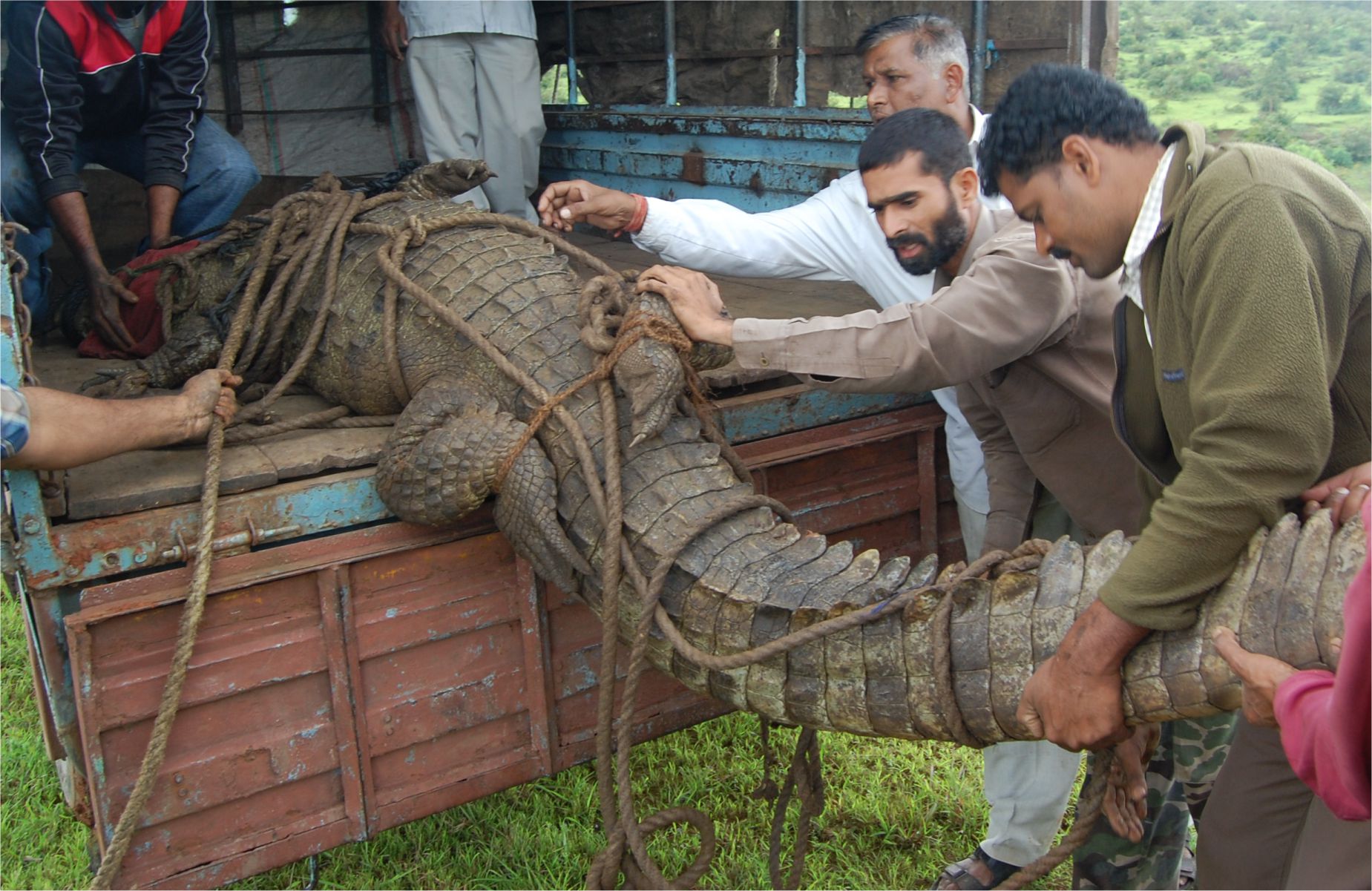
CROCODILES
Crocodiles found in Krishna river are Indian marsh crocodiles (Crocodylus palustris). Occasional incidences of human-crocodile conflict occur in Krishna river basin. The most common cause of the conflict is either destruction or loss of crocodile habitats and their hatching and basking sites caused by humans. The problem animal needs to be captured and relocated in a similar habitat somewhere else, whenever such incidences of conflict occur.
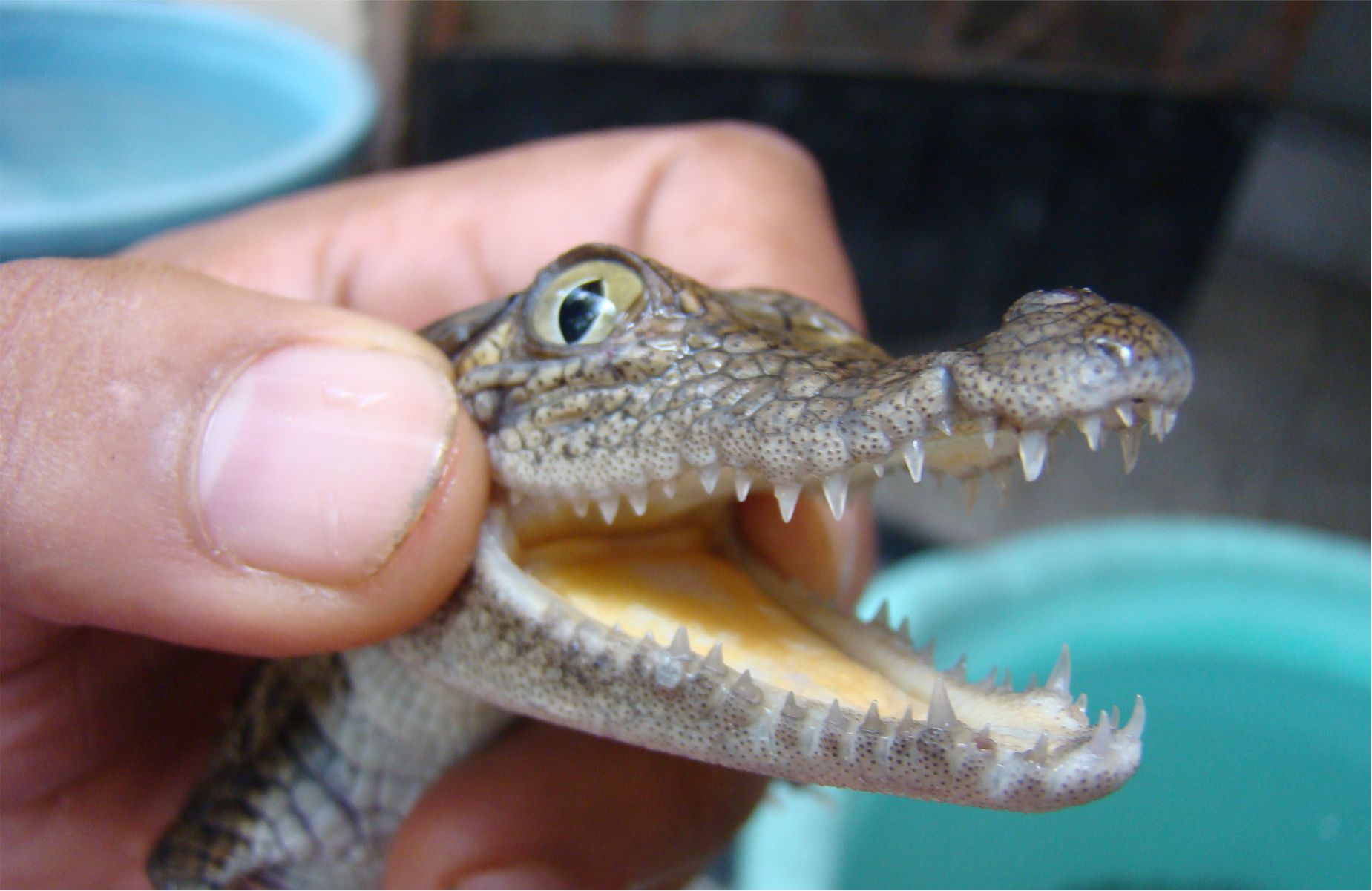
BABY CROCODILES
Indian marsh crocodile female lays 25-30 eggs in the period between April to June. She is very vigilant during this period and aggressively protects the eggs from potential predators. However, only 1% of the hatchlings survive to adulthood since both, eggs and the hatchlings are devoured by large birds and reptiles like monitor lizards. Some of the surviving hatchlings are commonly trapped in fishermen’s nets and need to be rescued.
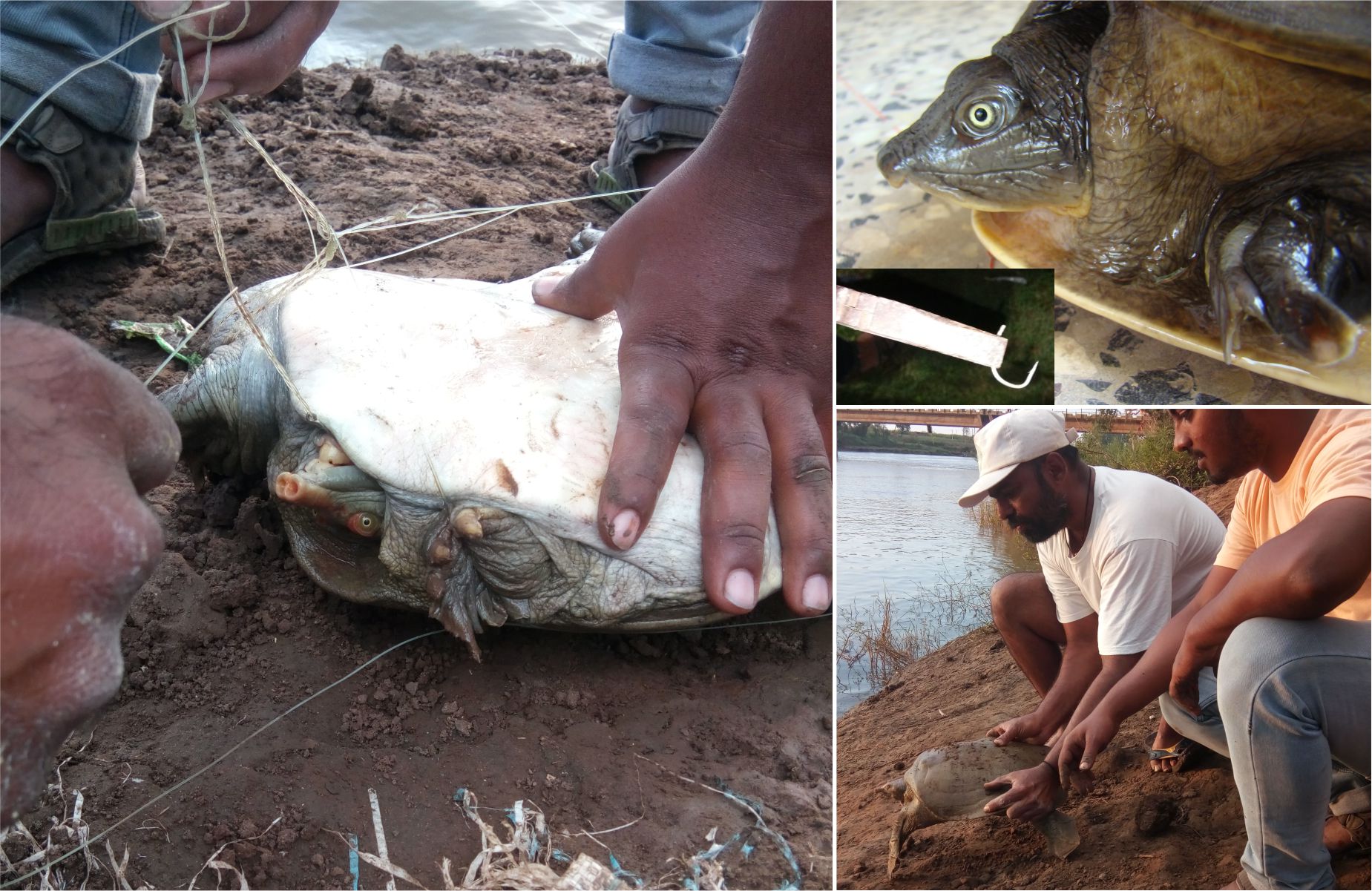
FLAPSHELL TURTLES
Indian flapshell turtles (Lissemys punctata) are often caught on the fishing hook or in the fishnet. Their rescue is difficult since they retract their necks while attempting to remove hook or net.
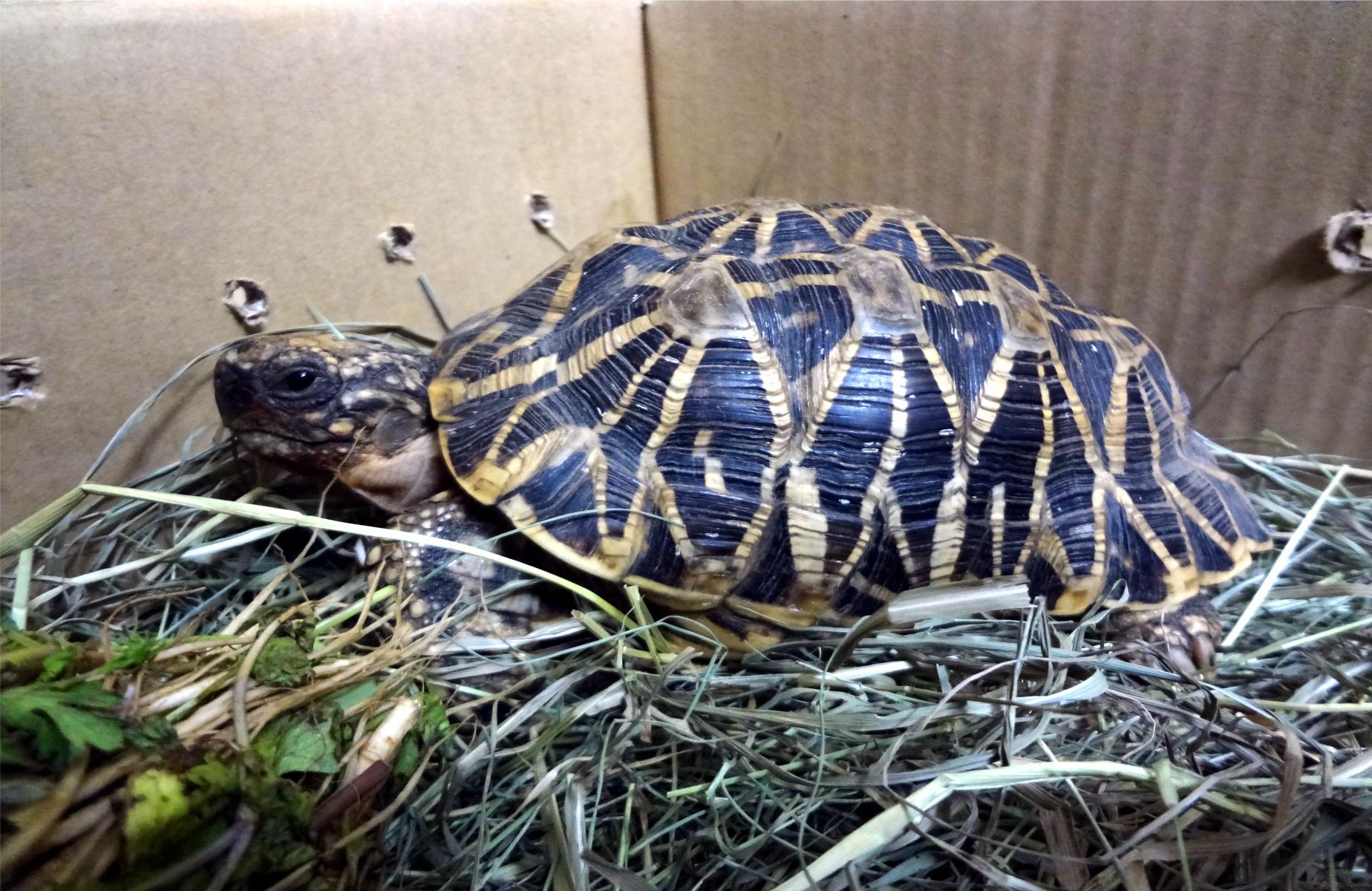
STAR TORTOISE
Indian star tortoise (Geochelone elegans) is a species threatened by habitat loss, poaching and illegal wildlife trade. They are trafficked because of beautiful design on their shells and are sold in Pet trade. It frequently needs to be seized from traffickers and rehabilitated.
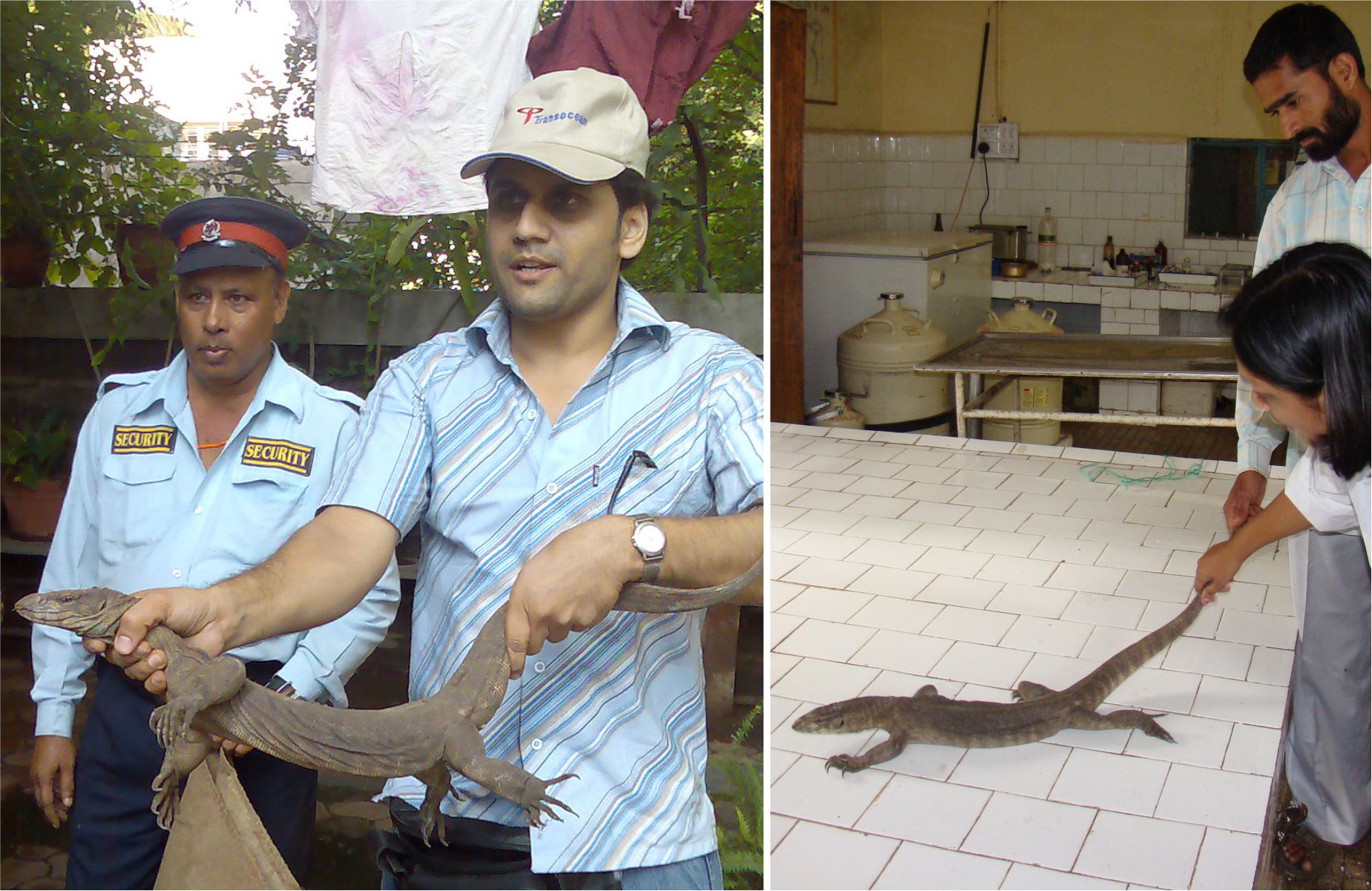
MONITOR LIZARDS
Indian Monitor lizards (Varanus bengalensis) have been our elusive, innocuous neighbors for centuries. However, its occasional sighting in human settlement scares the people due to its fearsome appearance. Some people poach the monitors for bush meat. There is a widespread superstition in the Indian rural society that the oil extracted from body fat of this lizard has medicinal properties and it can cure chronic respiratory disorders. Therefore, it needs to be rescued immediately, when seen in the human settlement.

HYENAS
Being a scavenger, Indian striped hyena (Hyaena hyaena) is a true sanitation worker of the nature. Unfortunately, it is forced to cross the man-made roads in search of food due to shrinking habitats and often gets injured or killed. Its appearance in human society is always unwelcome due to some weird superstitions about it. Sometimes, Hyenas also fall in open wells, get injured and need to be rescued.

JACKALS
Indian jackal (Canis aureus indicus) typically inhabits lowlands on the outskirts of towns, villages and farms. Its occasional appearance confuses people and its pups are commonly mistaken as dog pups. They usually get injured or killed by vehicles while crossing the roads.

MONKEYS
Being arboreal creatures, monkeys often walk on high voltage power lines and suffer severe electric shocks. They need to be rescued and treated. Sometimes they even need a limb amputation. They are also the common victims of stray dog attacks. Monkeys commonly found in our region are Grey Langurs (Semnopithecus entellus) and Bonnet macaques (Macaca radiata)

BATS
Indian fruit bats (Pteropus medius), Indian sheath tailed bats (Taphozous sp.) and Indian pipistrelle ( Pipistrellus coromandra) are one of the principal pollinators in the nature. They have been deprived of shelter and natural food sources like fruits and nectar, because of severe deforestation in the last few decades. Hence, occasional bat raids on orchards leads to their conflict with humans. Bats suffer starvation and dehydration during summer. They also get injured by collision with solid objects and electrical injuries caused by hanging on high tension electrical wires.

ASIAN PALM CIVETS
Asian palm civets (Paradoxurus hermaphroditus) are innocuous creatures that secretively live in places with less human presence such as dilapidated buildings, cemeteries etc. But because of their elusiveness, there is a weird superstition about them that they break the skulls and eat brains of human newborns and infants. This is not at all true. Therefore, a Civet needs to be immediately rescued once it is seen in human settlement.

SMALL INDIAN CIVETS
Small Indian civets (Viverricula indica) are least concerned as per IUCN red list. However, they usually get killed while crossing roads. They are also poached or illegally trafficked in some parts of India for extracting a scented substance known as ‘musk’ from their anal glands. This substance is used for some religious rituals.

LEOPARDS
Incidences of leopards (Panthera pardus fusca) straying in human settlement are increasing due to habitat loss and altered behavioral patterns such as breeding in the sugarcane farms, preying on stray dogs and human children. Therefore, whenever a leopard strays in human settlement, it is usually chased by over-excited and rioting crowd. Such leopards become so confused and aggressive that they attack the chasing humans. These animals need to be captured and released back into the natural habitat.

GAUR
The Gaur is the largest species among the wild cattle which feeds on different types of vegetation and lives in the evergreen, semi-evergreen, moist deciduous forests of India. These beasts are forced to stray in human settlements due to number of reasons such as deforestation and shrinking habitats, scarcity of food and water after monsoon, insufficient growth of native vegetation caused by the biological invasion of exotic plants like wattle, lantana, eucalyptus, mesquite etc. and expanding area of sugarcane plantations around the towns and villages which causes their displacements. Such a strayed animal often runs amok when chased by over-excited, rioting crowd and gets itself injured by colliding with surrounding objects or by falling in trenches. Rescue operations in such situations are extremely difficult and animal fatality rate is very high.

ELEPHANTS
Many temples and monasteries in the former princely states of India had a tradition to keep an elephant (Elephas maximus indicus), which has continued till today after Indian independence. Such elephants are victims of negligence and abuse at many places. Being related to the religion and faith, these issues are very sensitive. Legal battle to rescue and rehabilitate such elephants is a complicated procedure and a cause of conflict.

PANGOLINS
Pangolin is the world’s most trafficked wild animal and is therefore a critically endangered species. Most of them are slaughtered and served as a delicacy in the restaurants of South East Asia. Therefore, Pangolin rescue operation holds a special importance in wildlife management. Indian Pangolins (Manis crassicaudata) are commonly found in our area.

COMMON BIRDS AROUND HUMAN SETTLEMENT
Small to medium sized birds usually suffer from heat stress, kite string injuries and electric shocks due to sitting on high voltage power lines. Especially, the birds that commonly inhabit around human settlements such as Grey heron (Ardea cinerea), Cattle egret (Bubulcus ibis), Gray hornbill (Ocyceros birostris), Asian koel (Eudynamys scolopaceus), Red vented Bulbul (Pycnonotus cafer), Coppersmith Barbet (Psilopogon haemacephalus) are the usual victims.

BIRDS OF PREY
Kites such as Black kites (Milvus migrans), Black winged kites (Elanus caeruleus) and Brahminy kite (Haliastur indus) are hunter-scavengers which prey on rodents as well as animal carcasses and slaughtered animal remains. Thus, they help humans get rid of nuisance creatures as well as animal waste. They are common victims of kite string injuries, electrical burns and collision with vehicles.

OWLS
Owls are believed to be a sign of bad omen by many people. This superstition has made their presence unwanted in the human residential area. However, owls are natural pest control. They usually prey on rodents that are nuisance creatures for humans. They are a crucial part of the ecosystem. Owls commonly found in our area are Barn owls (Tyto alba) and occasionally Mottled wood owls (Strix ocellata). Wings and legs of owls often get entangled in kite strings. Such birds may remain in hanging position for hours and die due to dehydration and heat stress. Injured owls and juvenile owls that have been fallen from the nest need to be rescued.

MANUFACTURING OF CAGES FOR WILDLIFE
Nature conservation society manufactures cages to trap and transport the animals like leopards, bears, monkeys etc. The cages are carefully designed as well as customized considering the natural behavior of animals and their safety. Various types of cages have been manufactured until now, for Sangli forest department in Maharashtra state and Manendragarh forest department in Chhattisgadh state.
